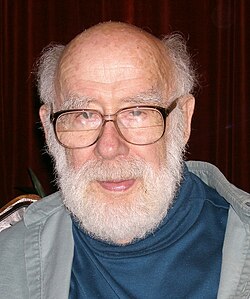John W. Gofman | |
|---|---|
 John Gofman at his home in San Francisco in August 2005 | |
| Born | September 21, 1918 |
| Died | August 15, 2007 (aged 88) |
| Citizenship | United States |
| Alma mater | Oberlin College (Bachelor's) University of California at Berkeley (Ph.D) University of California, San Francisco (M.D.) |
| Awards | Right Livelihood Award |
| Scientific career | |
| Fields | Biology, Chemistry, Physics, Medicine |
| Thesis | The discovery of Pa-232, U-232, Pa-233, and U-233. The slow and fast neutron fissionability of U-233.[1] (1943) |
| Doctoral advisor | Glenn T. Seaborg |
John William Gofman (21 September 1918 – 15 August 2007) was an American scientist and advocate. He was Professor Emeritus of Molecular and Cell Biology at the University of California at Berkeley.
Gofman pioneered the field of clinical lipidology, and in 2007 was honored by the Journal of Clinical Lipidology with the title of "Father of Clinical Lipidology".[2] With Frank T. Lindgren and other research associates, Gofman discovered and described three major classes of plasma lipoproteins, fat molecules that carry cholesterol in the blood. The team he led at the Donner Laboratory went on to demonstrate the role of lipoproteins in the causation of heart disease.
Gofman advocated for the adoption of the Linear No-Threshold (LNT) model as a means of estimating actual cancer risks from low-level radiation and as the foundation of the international guidelines for radiation protection.
Gofman's earliest research was in nuclear physics and chemistry, in close connection with the Manhattan Project. He codiscovered several radioisotopes, notably uranium-233 and its fissionability; he was the third person ever to work with plutonium and, having devised an early process for separating plutonium from fission products at J. Robert Oppenheimer's request,[3] he was the first chemist ever to try and isolate milligram quantities of plutonium.[4]
In 1963 Gofman established the Biomedical Research Division for the Livermore National Laboratory, where he researched the connection between chromosomal abnormalities and cancer.
Later in life, Gofman became an anti-nuclear advocate. Beginning in 1971, he was Chairman of the Committee for Nuclear Responsibility. He was awarded the Right Livelihood Award for "his pioneering work in exposing the health effects of low-level radiation" on the Chernobyl disaster's area population.[5]
In his 1996 book[6] Gofman claimed that exposure to medical x-rays was responsible for about 75 percent of breast cancers in the United States. This order of magnitude has been somehow confirmed by the increase in breast cancer incidence following mammography screening in the USA and in France.[7]
- ^ Cite error: The named reference
Gofman PhD Dissertationwas invoked but never defined (see the help page). - ^ Cite error: The named reference
Brown-Journal of Clinical Lipidology 2007was invoked but never defined (see the help page). - ^ Cite error: The named reference
Gofman UC-California Obituarywas invoked but never defined (see the help page). - ^ Cite error: The named reference
Nuclear Witnesses p 85was invoked but never defined (see the help page). - ^ "Mission Statement of the Committee for Nuclear Responsibility".
- ^ "Preventing Breast Cancer Second Edition: 1996".
- ^ Corcos D, Bleyer A (2020). "Epidemiologic Signatures in Cancer". N Engl J Med. 382 (1): 96–97. doi:10.1056/NEJMc1914747. PMID 31875513.